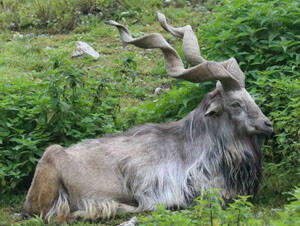
Oreamnos americanus
Oreamnos americanus,Mountain Goat,Rocky Mountain Goat
Snow sheep (scientific name: Oreamnos americanus) is also known as Mountain ···

Capricornis sumatraensis
Sumatran serow, Ming mane sheep, mountain donkey, rock donkey, four-legged beast, Pegasus, shepherd
Capricornis sumatraensis (English: Mainland Serow, Serow, Spanish: Serau de ···

Capricornis crispus
Capricornis crispus,Japanese Serow
Japanese Serow (scientific name: Capricornis crispus) is also known as Japan···

Nilgiritragus hylocrius
Nilgiritragus hylocrius,Nilgiri Tahr
The Nilgiri Tahr sheep (scientific name: Nilgiritragus hylocrius) has a fore···

Arabitragus jayakari
Arabitragus jayakari, Arabian Tahr,Wa’al Al ‘arabi
Arabian Tahr (scientific name: Arabitragus jayakari) English: Arabian Tahr, ···

Capra walie
Capra walie
The Walia Ibex (Capra walie) has no subspecies. Walia Ibex are active or fee···

Capra pyrenaica
Iberian ibex, Iberian wild goat, Spanish goat, Iberian wild goat, Alpine wild goat
Spanish ibex (scientific name: Capra pyrenaica) is called Iberian Wild Goat,···

Capra nubiana
Capra nubiana
Nubian ibex (scientific name: Capra nubiana) English Nubian Ibex, Spanish Í···

Capra ibex
Ibex, Alpine Ibex, Capra Ibex, Alpine Ibex
Ibex (scientific name: Capra ibex) English Alpine ibex, French Bouquetin des···

Capra falconeri
Capra falconeri,spiral-horned goat
Markhor (scientific name: Capra falconeri) is called Markhor in English, Mar···

Capra cylindricornis
Capra cylindricornis
Eastern Caucasian ibex (scientific name: Capra cylindricornis) English Easte···

Capra caucasica
Capra caucasica
West Caucasian ibex (scientific name: Capra caucasica) English Western Tur, ···

Capra hircus
Summer sheep, black sheep, domestic goat
Goats (scientific name: Capra hircus) are one of the earliest domesticated l···

Capra aegagrus
Capra aegagrus,Persian Ibex
Wild goats (scientific name: Capra aegagrus) are also known as Wild Goat and···

Ammotragus lervia
Ammotragus lervia,Bearded sheep, Barbary sheep, Berber sheep
The scientific name of the Barbary Sheep is Ammotragus lervia, which is also···

Addax nasomaculatus
Addax nasomaculatus (scientific name: Addax nasomaculatus) has two subspecie···

Oryx leucoryx
Oryx leucoryx,Arabian Oryx, Arabian Oryx, Arabian Oryx
Arabian Oryx (scientific name: Oryx leucoryx) is called Arabian Oryx in fore···

Oryx gazella
Oryx gazella,Gemsbok,Gemsbok
South African Oryx gazella (scientific name: Oryx gazella) is also known as ···

Oryx dammah
Oryx dammah,Scimitar-horned oryx,Scimitar-horned oryx, white oryx, white oryx, scimitar-horned oryx, scimitar-horned oryx
Scimitar-horned oryx (scientific name: Oryx dammah) is called Scimitar-horne···

Oryx beisa
East African Gemsbok, Oryx oryx, East African Gemsbok
East African Oryx (scientific name: Oryx beisa) English Beisa Oryx, French O···

Hippotragus niger
Hippotragus niger,Sable Antelope
Sable Antelope (scientific name: Hippotragus niger) is also known as Sable A···
